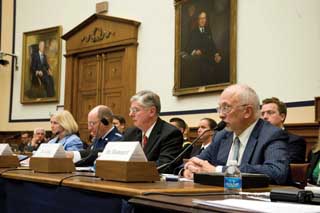
Long-term confidence in a critical element of the US nuclear deterrent depends on the success of the B61 life extension program (LEP) now underway at Sandia, Labs President and Director Paul Hommert said in recent congressional testimony.
“In order to sustain high confidence in the safety, security, and reliability of the B61 into the next decade, it is our technical judgment that we must complete the life extension program currently being executed,” Paul told the US House of Representatives’ House Armed Services Committee’s (HASC) Strategic Forces Subcommittee during a 90-minute hearing on weapons modernization.
Paul testified that the B61 LEP must be completed because of well-documented technology obsolescence and aging issues that he called “not surprising for a system the oldest units of which were manufactured and fielded in the late seventies, with some components dating to the sixties.”
He testified — along with Gen. C. Robert Kehler, commander, US Strategic Command; Madelyn R. Creedon, DoD assistant secretary for Global Strategic Affairs; and Donald Cook, NNSA deputy administrator for Defense Programs — during the hearing “Nuclear Weapons Modernization Programs: Military, Technical, and Political Requirements for the B61 Life Extension Program and Future Stockpile Strategy.”
The B61 gravity bomb is the cornerstone of US extended deterrence to its allies. It is flexible and can be delivered by strategic B-2 bombers and select Dual Capable Aircraft in the North Atlantic Treaty Organization (NATO), as well as F-15 and F-16 fighters. The B61 also has some of the oldest components in the US nuclear weapons stockpile, which is safe, secure, and reliable, but aging, Paul said.
The hearing was intended to provide Congress with expert views on the B61 LEP and to advance discussion on the subject. Rep. Mike Rogers, R-Ala., the HASC Strategic Forces Subcommittee chair, opened the hearing by asking the witnesses to “help us understand the details of the programs, the requirements that are driving it, its history and current status, and its outlook for the future.”
Funding uncertainties a challenge
Paul emphasized that the B61 LEP is essential, on cost, and on schedule, rigorously managed, and has the appropriate, focused resources and expert staff needed. However, Paul and the others who testified made it clear the biggest risk to the B61 LEP is not technical failure, but funding.
The impacts of fiscal year 2014 budget decisions haven’t been applied to schedule and lifecycle costs, Paul said. Given the current budget uncertainties and reductions forecast due to sequestration, he added it is likely that the LEP will experience schedule delays and accompanying higher overall costs.
The B61 LEP addresses all known issues related to aging or technology obsolescence, and is the minimum program that meets DoD and NNSA requirements, he said.
Paul told the subcommittee that Sandia is well into the full-scale engineering development phase of the LEP. A baseline design review is scheduled for fall of 2015.
To emphasize the point of technology obsolescence, during his testimony Paul showed HASC members an outdated vacuum tube radar component and contrasted it with a new radio-frequency integrated circuit radar for the B61-12.
Paul said Sandia has spent $253 million of the $2.65 billion estimated incremental cost of design, engineering, development, and production allocated to Sandia for the B61 LEP, the amount specified in the Weapon Development Cost Report of June 2012.
“At Sandia, we met all major FY13 program milestones for the B61 LEP on, or under, cost — although sequestration caused some of the work scope to be deferred to FY14,” he said.
Paul pointed to rigorous project management controls Sandia has put in place for all the Labs’ weapons modernization work. Sandia also has drawn on resources, staff, and expertise nurtured through interagency work on broader national security challenges to meet the urgent demands of Sandia’s core nuclear weapons mission, he said.
Last place for half-measures
Paul said that in his 37-year professional career he has had the extraordinary privilege to work at three institutions whose core responsibilities are nuclear weapons: the Atomic Weapons Establishment in the United Kingdom, Los Alamos National Laboratory, and Sandia.
“In that time, I have worked with many exceptional individuals who have dedicated their professional lives to the innovation, science, and engineering excellence required to ensure that these unique devices of mankind are safe, secure, and reliable,” he said. “I fully recognize the fiscal environment in which we are operating, and throughout my written testimony I have indicated our focus on cost management and cost efficiency. However, my experience deeply reminds me that nuclear weapons are the last place for half measures or corner cutting.”